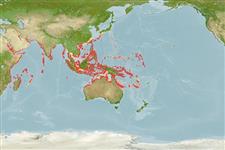Common names from other countries
Environment: milieu / climate zone / depth range / distribution range
Ecologia
Associadas(os) a recifes; intervalo de profundidade 0 - 30 m (Ref. 848). Tropical; 36°N - 23°S, 32°E - 175°E (Ref. 848)
Indo-West Pacific: Red Sea, Indonesia to Melanesia, north to Japan and south to Australia.
Length at first maturity / Tamanho / Peso / Idade
Maturity: Lm ? range ? - ? cm
Formation: encrusting, can be submassive; small colonies have a conspicuous central corallite. Corallites: plocoid; becomes widely spaced at colony edges. Septa: with long pointed teeth. Fleshy tissue over skeleton present. Color: dark brown, rust red, or green (Ref. 848).
Life cycle and mating behavior
Maturidade | Reprodução | Desova | Ovos | Fecundidade | Larvas
Members of the class Anthozoa are either gonochoric or hermaphroditic. Mature gametes are shed into the coelenteron and spawned through the mouth. Life cycle: The zygote develops into a planktonic planula larva. Metamorphosis begins with early morphogenesis of tentacles, septa and pharynx before larval settlement on the aboral end.
Veron, J.E.N. 2000. (Ref. 848)
Categoria na Lista Vermelha da IUCN (Ref. 130435: Version 2024-1)
Categoria CITES (Ref. 108899)
Not Evaluated
Utilização humana
| FishSource |
Ferramentas
Mais informação
Idade/TamanhoCrescimentoComprimento-pesoComprimento-comprimentoMorfologiaLarvasAbundância
Fontes da internet
Estimates based on models
Preferred temperature
(Ref.
115969): 25.5 - 29.3, mean 28.6 (based on 3339 cells).
Categoria de preço
Unknown.
